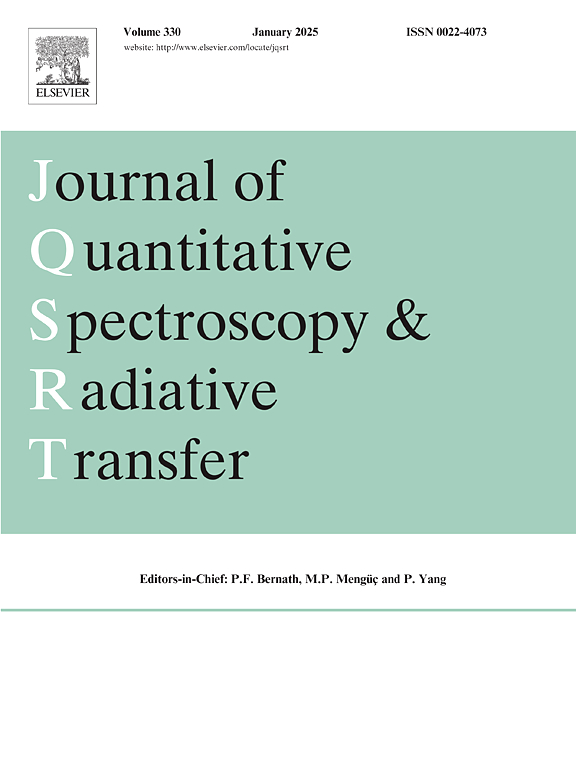Temperature and H2O concentration detection in axisymmetric combustion spaces using spontaneous emission and absorption combined signals
IF 2.3
3区 物理与天体物理
Q2 OPTICS
Journal of Quantitative Spectroscopy & Radiative Transfer
Pub Date : 2025-04-30
DOI:10.1016/j.jqsrt.2025.109503
引用次数: 0
Abstract
Combustion temperature and gas concentration are important parameters for understanding combustion status. Two types of signals including spontaneous emission and absorption signals are usually used for combustion temperature and gas concentration measurement. In this work, a combined method utilizing both spontaneous emission and absorption signals is proposed for combustion detection. The integrated spectral band ratio (ISBR) method based on spontaneous emission signals is first applied to reconstruct the temperature field. Then, with the known combustion temperature, the absorption tomography (AT) method using absorption signals is employed to reconstruct the gas concentration field. Several factors including absorption path layout and number, scanning band number, which influence the accuracy of the combined method are investigated and optimized. Then, the combined method is applied to reconstruct two-dimensional temperature and gas concentration fields of axisymmetric combustion spaces. Results show that the combined method retains the advantage of the ISBR method with high accuracy of temperature measurement, while significantly improving gas concentration measurement accuracy compared to the ISBR method. Additionally, the combined method offers clear advantages over the AT method in terms of simpler apparatus.
利用自发发射和吸收组合信号检测轴对称燃烧空间的温度和水浓度
燃烧温度和气体浓度是了解燃烧状态的重要参数。燃烧温度和气体浓度的测量通常采用自发发射和吸收两种信号。在这项工作中,提出了一种利用自发发射和吸收信号的组合方法来检测燃烧。首次应用基于自发发射信号的积分光谱带比(ISBR)方法重建温度场。然后,在已知燃烧温度的情况下,利用吸收信号的吸收层析成像(AT)方法重建气体浓度场。研究并优化了影响组合方法精度的因素,包括吸收路径布局和路径数、扫描带数等。然后,采用组合方法重构了轴对称燃烧空间的二维温度场和气体浓度场。结果表明,该组合方法既保留了ISBR法测温精度高的优点,又较ISBR法显著提高了气体浓度测量精度。此外,就更简单的设备而言,该组合方法比AT方法具有明显的优势。
本文章由计算机程序翻译,如有差异,请以英文原文为准。
求助全文
约1分钟内获得全文
求助全文
来源期刊
CiteScore
5.30
自引率
21.70%
发文量
273
审稿时长
58 days
期刊介绍:
Papers with the following subject areas are suitable for publication in the Journal of Quantitative Spectroscopy and Radiative Transfer:
- Theoretical and experimental aspects of the spectra of atoms, molecules, ions, and plasmas.
- Spectral lineshape studies including models and computational algorithms.
- Atmospheric spectroscopy.
- Theoretical and experimental aspects of light scattering.
- Application of light scattering in particle characterization and remote sensing.
- Application of light scattering in biological sciences and medicine.
- Radiative transfer in absorbing, emitting, and scattering media.
- Radiative transfer in stochastic media.

 求助内容:
求助内容: 应助结果提醒方式:
应助结果提醒方式:


